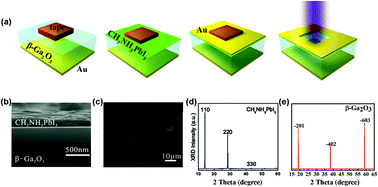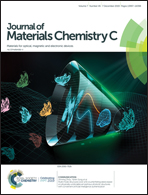Performance-enhanced solar-blind photodetector based on a CH3NH3PbI3/β-Ga2O3 hybrid structure
Abstract
Solar-blind photodetectors have drawn great attention due to their excellent accuracy and precision ignoring the electromagnetic radiation interference from the sun. Here, we demonstrate a solar-blind photodetector by combining the inorganic wide bandgap semiconductor β-Ga2O3 with organic–inorganic hybrid perovskite (CH3NH3PbI3) for the first time. The photodetector with an intelligent architecture design and assembly technique was developed via a facile and low-cost solution processing method. Compared with the pure β-Ga2O3 photodetector, the performances of the device based on the CH3NH3PbI3/β-Ga2O3 hybrid structure were significantly enhanced. The photo-to-dark current ratio is 1460, the responsivity and detectivity are 85 mA W−1 and 1.28 × 1011 Jones, respectively. The device exhibits excellent reproducibility and stability under DUV light illumination, the rise and decay times are 0.11 and 0.45 s, respectively. The superior solar-blind/UVA rejection ratio (I254nm/I325nm) with a value of 221 indicates that our fabricated photodetector has an excellent sensitivity in the solar-blind region. This work can offer a new strategy to develop cheap and high-performance solar-blind photodetectors based on β-Ga2O3.



 Please wait while we load your content...
Please wait while we load your content...